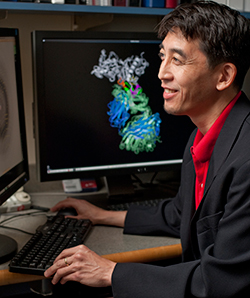An experimental vaccine regimen in animal models elicited antibodies that neutralize dozens of HIV strains from around the world, in a major advance in the NIH's efforts to find a safe and effective vaccine.
While the study was conducted on mice, guinea pigs, and monkeys, a preliminary human trial could begin in the second part of next year. Researchers hope the vaccine initiates the production of the antibodies needed by individuals to protect them from infection.
 Dr. Peter Kwong (Photo courtesy of National Institute of Allergy and Infectious Diseases)The findings were reported June 4 in Nature Medicine.
Dr. Peter Kwong (Photo courtesy of National Institute of Allergy and Infectious Diseases)The findings were reported June 4 in Nature Medicine.
The vaccine works by targeting a protein on the surface of HIV that the virus uses to enter human cells. To develop the vaccine, researchers engineered many different immunogens, which are proteins designed to provoke an immune response—in this case, the release of antibodies. The team tested which immunogens were most effective in the animals and analyzed the results. The vaccine caused the immune systems of the animals to produce antibodies that could neutralize up to 31% of 208 different strains of HIV.
"In this context, the vaccine regimen 'worked,'" said Dr. Peter Kwong, lead study author and chief of the Structural Biology Section at the NIH's National Institute of Allergy and Infectious Diseases (NIAID) Vaccine Research Center, as quoted by Newsweek. "However, we have not yet challenged the animals to see if they would be protected from HIV, as we are still in the process of optimizing the immune response.
"Prior to this study, no vaccine regimen could reproducibly elicit antibodies capable of neutralizing more than a small fraction of the diverse strains of HIV that typify natural infection."
Broadly neutralizing antibodies naturally occur in about 10–20% of people living with HIV, but years after infection. By that time, the virus is too well developed and entrenched to eradicate. Scientists have identified and characterized the sites on HIV where each known broadly neutralizing antibody binds. They are developing vaccine candidates based on these sites.
The strategy represents one of two broad, complementary approaches the NIAID is pursuing to develop an HIV vaccine. The other involves evaluating the most promising vaccine candidates in human trials, building on the results by examining blood and other specimens, and using the information to improve vaccine regimens. This method was used to develop the HIV vaccine in the RV144 trial and the one currently under study in the HVTN 702 trial.
Scientists are seeking ways to make the vaccine more potent and achieve more consistent results with fewer injections. They also are isolating additional broadly neutralizing antibodies generated by the vaccine in monkeys to assess their ability to protect the animals from SIV (the simian version of HIV). The findings will be used to optimize the vaccine and develop a version for testing in human clinical trials.
Read more:
HIV vaccine elicits antibodies in animals that neutralize dozens of HIV strains
In the Vanguard of Vaccine Research